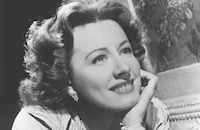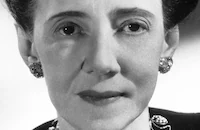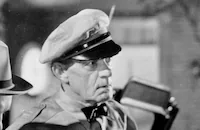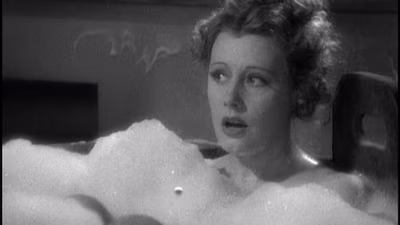High, Wide and Handsome

Brief Synopsis
Cast & Crew
Rouben Mamoulian
Irene Dunne
Randolph Scott
Dorothy Lamour
Elizabeth Patterson
Raymond Walburn
Film Details
Technical Specs

Synopsis
In 1859, in Titusville, Pennsylvania, Doc Watterson's traveling medicine show burns down, and Grandma Cortlandt takes him and his daughter Sally in to work on her farm with her grandson Peter. Peter, meanwhile, drills for rock oil, dreaming of supplying the world with affordable oil. Sally and Peter soon fall in love, and he promises to build her a house on a hill among apple blossoms. Peter continues to drill until, during their wedding reception, he strikes oil and starts an oil boom on farms across the state. Soon, however, railroad magnate Walt Brennan, hoping to force the farmers to sell their oil-rich land to him, raises freight rates on his railroad. Peter, refusing to be part of Brennan's monopoly, works long hours to devise a scheme to defeat his foe and finally invents a pipeline. Brennan's friends, strangers to the small town, bring gambling and prostitutes to the local saloon, enraging the community. Brennan bids for a 20-mile stretch of land owned by saloon proprietor Joe Varese, which Peter needs for his pipeline. Varese's price is the Cortlandt hill, where Sally's house is to be built. Sally, meanwhile, has befriended saloon singer Molly, who has been ostracized by the church elders, and has come to Varese's bar to help her audition. When Peter sees Sally performing along with Molly, he is furious. Sally, in turn, is enraged when she discovers Peter has given her hilltop land to Varese and, tired of sitting at home waiting for Peter, runs away with Bowers Carnival along with her father. While Peter and the farmers work through the winter, forced to guard the pipeline from Brennan's night-time saboteurs, Sally's popularity as a singer grows. When Peter has only two days to complete three miles of pipeline, Brennan buys the bank that holds the mortgage on the refinery which Peter uses and threatens to pull the mortgage if the refinery grants Peter more time. Then, just after Sally receives an offer from Mr. Barnum to perform in New York, Molly tells her of Peter's trouble, and Sally races to Titusville, promising Peter to bring him help. As a few loyal men work with Peter to hang the pipeline over a hill, Brennan's men come with whips to destroy it, but Sally's circus friends arrive with elephants in time to defeat Brennan and finish the pipeline. As the circus leaves, Sally and Peter are reconciled.

Director

Rouben Mamoulian
Cast

Irene Dunne

Randolph Scott

Dorothy Lamour

Elizabeth Patterson

Raymond Walburn

Charles Bickford

Akim Tamiroff

Ben Blue

William Frawley

Alan Hale

Irving Pichel
Stanley Andrews

James Burke
Roger Imhof

Lucien Littlefield
Purnell Pratt
Edward Gargan
Helen Lowell
Tommy Bupp

Russell Hopton
Billy Bletcher
Frank Sully
Jack Clifford

Claire Macdowell
Ivan Miller
Raymond Brown
Constance Bergen
Fred Warren
Sherry Hall
Rolfe Sedan
Marjorie Cameron
John T. Murray

Edward Keane
Pat West
John Maurice Sullivan
Ernest Wood

Lew Kelly
Dell Henderson
John Marshall
Philip Morris
Frank Shannon
George Macquarrie
Paul Kruger
Crew
Travis Banton
Russell Bennett
Hans Dreier
A. E. Freudeman
John Goodman
Oscar Hammerstein Ii
Oscar Hammerstein Ii
Charles Hisserich
Arthur Hornblow Jr.
Gordon Jennings
Don Johnson
Jerome Kern
William Le Baron
Rouben Mamoulian
Archie Marshek
Victor Milner
Boris Morros
George O'neil
Leroy Prinz
Theodor Sparkuhl
Joseph C. Youngerman
Adolph Zukor

Videos
Movie Clip




Film Details
Technical Specs

Articles
Wide, High and Handsome -
As with that early sound experiment, High, Wide and Handsome would work diligently to incorporate the songs into the narrative, instead of standing apart from the story, as in a Busby Berkeley movie. Mamoulian biographer David Luhrssen writes that Hammerstein "devoted most of the fall of 1937 to the screenplay, working closely with Kern to integrate the score with the plot, and with Mamoulian on a shooting script that married romance with fact and fantasy."
The romance emerges between Peter Cortlandt (Randolph Scott, at peak pulchritude) and medicine show performer Sally Watterson (Irene Dunne). Cortlandt is an eccentric farm boy pursuing his dream of discovering oil, while Sally is a showgirl for her dad's traveling revue, kicking her gams to sell bogus elixirs. When their wagon goes up in flames Peter offers them to stay at his place. It is under a grove of apple blossoms where Peter and Sally fall in love and where Dunne beautifully sings "The Folks Who Live on the Hill" (Lyrics - Hammerstein, Music - Kern), which would become a standard covered by Bing Crosby, Peggy Lee and Nina Simone.
This reverie, shot in the wilds of Chino, California, is short-lived. Because Peter does strike oil and with it arrives an endless litany of business problems, chief among them the railroad baron Walt Brennan (Alan Hale), who jacks up the freight prices, knowing Peter has no other way of getting his crude oil refined. So instead Peter decides to build his own pipeline across the country. Brennan sends hired thugs to destroy the lengthening line, leaving Peter no time to live with his new wife Sally. Sally, lonely and rejected, runs off to the circus to reunite with her dad. It is only with Peter on the brink of destruction and with Brennan's mercenary army closing in on him, that she is forced to make a decision on their future.
Paramount executive Adolph Zukor told producer Arthur Hornblow Jr. to "spare no expense", and it's a gorgeous-looking film, shot by Theodor Sparkuhl and Victor Milner with an impressive sense of scale. The sheer material undertaking of the pipeline is made clear in overhead shots of geometric beauty (soon to be chopped to bits by Brennan's boys). The whole production has a swashbuckling energy, provided in no small part by the leads. Early in her career, Dunne studied to be an opera singer, and she gets to showcase the range in her voice, from the sweetly chirping "The Folks Who Live on the Hill" to the brassy belting of "Allegheny Al." Randolph Scott lends his aw-shucks physicality to the role, which he truly lets loose in the climactic brawl between Brennan's whip-wielding men, Peter's pipeline workers and Sally's circus pals. The whole film's attempt to blend picaresque romance, Western adventure and big top drama explodes in this wild fracas, in which bearded ladies are beating up cowboys while elephants run wild.
It also features a who's-who of character actors, who invest bit parts with the same wooly energy as the rest of the feature. Elizabeth Patterson nearly steals the movie as Grandma Cortlandt, a sweet homebody with a poison tongue. There is also Raymond Walburn as Sally's con-man dad Doc Watterson, whose gravelly homespun voice could steal a lollipop from a baby. Also delightful is Akim Tamiroff as Joe Varese, a conniving nightclub owner who mischievously pets his numerous cats while waiting for Peter to accept a devious land purchase offer.
Mamoulian recalled it as "a very difficult story to film". It certainly had pressure to perform from Paramount, but the script had an uneven tone, from light romantic comedy to dark industrial adventure and back again. It was a disappointment for everyone involved - Mamoulian and Hammerstein would not have their contracts renewed at Paramount. The latter felt especially insulted, as Luhrssen reports in Mamoulian: Life on Stage and Screen. After the film's sneak preview, "Zukor crossed the floor of Hollywood's Riviera Country Club to shake Hammerstein's hand and say, 'That's the greatest picture we ever made.' A few months later, after failing to recoup his investment, Zukor walked past Hammerstein in a restaurant and looked through him as if he were a stranger." While it wasn't appreciated in its time, there is so much to savor here. Whether you are a fan of Oscar Hammerstein's lyrics, Mamoulian's elegant incorporation of Jerome Kern's music, or the inspired gallivanting of Dunne and Scott, it has something for nearly everyone.
By R. Emmet Sweeney

Wide, High and Handsome -
Quotes
Trivia
Notes
The opening title card for this film reads "Jerome Kern and Oscar Hammerstein's High, Wide and Handsome." Emma S. Hammerstein, Oscar Hammerstein's widow, filed suit against Paramount for using her husband's name in the title frame, alleging it inferred that Oscar Hammerstein was co-author of the story, instead of Oscar Hammerstein II. The New York Supreme Court denied a motion for examination before trial in connection with the suit on April 21, 1938. As reported in Hollywood Reporter on January 11, 1937, the film was shot on location at Chino, CA, with more than 3,000 extras. According to Hollywood Reporter news items, after orchard heater smoke and influenza forced the company to leave location shooting in Chino in mid-January 1937, the company returned February 1, 1937. Hollywood Reporter announced on February 4, 1937 that the film was back into production the previous day for two days' shooting of added scenes with Mitchell Leisen directing, although Leisen is not listed in the onscreen credits or in reviews. According to the Paramount Script Collection at the AMPAS library, George O'Neil wanted sole screenplay credit for the film, but Paramount offered him only "additional dialogue" credit. Under the Code of Practice rule of the Academy Writer-Producer Basic Agreement, O'Neil could not receive onscreen dialogue credit until Paramount assured the Academy that the film was a "musical production." On June 29, 1937, Film Daily announced that the film would not be put into general release following its Astor Theater run in New York until after January 1, 1938, and that it would be road shown in key cities. Motion Picture Herald release charts give a release date of October 1, 1937; it is unclear whether the 1 October date refers to the general release date or merely the roadshow engagements. Exploitation announcements and ads in Motion Picture Herald in December 1937 and January 1938 seem to corroborate that the film was released to smaller theaters in Jan. According to a Hollywood Reporter news item, Paramount negotiated with educational authorities at various universities to make this film part of the first-year curriculum for petroleum engineering students. Variety called the film "a cross-section of Americana tinged with too much Hollywood hokum." New York Times stated that the film "is not a gingerbread concoction with an overlayer of romantic whipped cream, but a beef and brawn pastry leavened by the Irene Dunne-Dorothy Lamour caroling." Modern sources list William Gilmore Beymer as technical adviser on this film.














